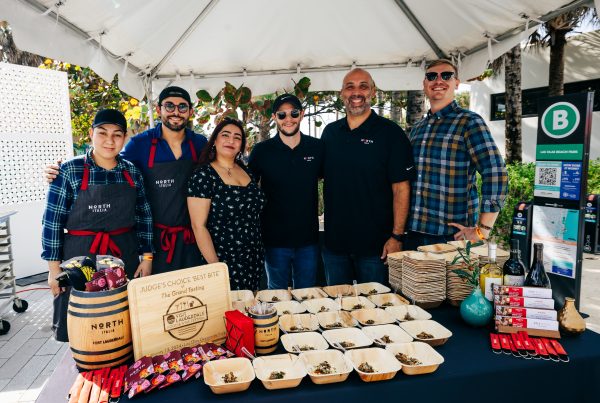Improve. Improving. Improvement.
Whether we’re talking about our health, our relationships, our golf swings or our cities, there are fewer words more universally satisfying. And they tend to surface repeatedly when George Brown discusses his priorities for the place he has called home for nearly 50 years. Brown, Boca Raton’s new city manager, is among its biggest boosters—a local official dedicated, through his long-term and day-to-day activities, to making Boca better.
“I’m kind of invested in this community,” says Brown, from his office in City Hall. “I’ve lived here since 1976, and I really care about the place.”
Brown was appointed to the position in January 2024 after serving 20 years as deputy city manager, and before that, another two decades in various administrative positions in the city. Outside, perhaps, of his predecessor Leif Ahnell, who spent 24 years as city manager, there is arguably no one who knows more about how the city is run than Brown. An approachable and trustworthy voice for Boca Raton, he plans to use his tenure to strengthen the public face of his department.
“One of the things that would go very far toward improving the residents’ perception of the city is their getting to know us as people, not just as ‘the city,’” he says. “They know the elected officials pretty well; with social media today, they know them better than they ever have. I would like the residents to know their staff, the people who work for them every day, as people. Because if we know each other, and we have a crisis like a bad storm, or something similar, it will be much easier for us to resolve problems if we’re working together.”
We sat down with Brown for a wide-ranging conversation, starting with his job description.
What does a city manager do? What falls under your purview?
The basic function of a city manager is the day-to-day administration of the city, and the carrying out of the policy direction of the mayor and city council. They set the goal. The manager sets the course with their input. And then the staff, with the manager’s guidance, carries out the journey—whatever that goal may be. It can be anything from as simple as, “Are we going to add a playground to a park?” to, “What are we going to do about our downtown’s future?” So it’s day-to-day administration, the effectuation of the policy direction of the city council, and providing professional advice to the council on questions and concerns.
So in a perfect world, you’re all working together for shared goals. Are there occasionally disagreements between the city manager’s office and the city council?
There could be. There may be an occasion where the staff or the manager recommends a certain course, and the council says no, we don’t want to go that way. That could occur more often in land development matters, where the staff may recommend approval of a proposal, and the council says, “No, we don’t think it’s in the best interests of the city,” or vice versa—we might recommend something not be approved, and the council may say, “We’ve considered that, but we think it’s reasonable to go ahead with it.” And that’s the normal course of business in the council-manager form of government.
Is there a general sense of unity on the Boca Raton city council?
I think so. The council has a general vision for what the city should be like. They work together collegially on issues. They don’t always agree, but once the decision has been made, everybody supports the decision, and they’re enthusiastic about that.
You’re succeeding Leif Ahnell, who was an institution in this role. Is your approach any different from his?

It’s not fundamentally different, in terms of approaching the work and the support of the council. But I am trying to provide the council with more information in public meetings, where they can have an opportunity to discuss it so that there’s more open dialogue. And we’re also looking at an expanded and improved strategic planning process. We started that last year and will be continuing it this year and into the future. We’ve tried to align the day-to-day activities, the project activities with the goals of the city as established by the city council to have a really clean alignment.
Where is Boca Raton leading the way right now in terms of the way the city is run?
I think we’re leading the way in being proactive when we can. An example is what we did with the Live Local Act [legislation, passed in 2024 by the Florida Senate and House, designed to boost development of affordable housing in the state—Ed.] within the past year or so. We knew we had to deal with this, so we dealt with it immediately, before most other cities had even looked at it. And we were also responsive to the [developer] community that said, “We want to bring in more housing, and we’re willing to include affordability.”
I think we are proactive in attempting to attract valuable business to the city—in other words, high-end businesses, businesses that bring good jobs to our economy. I think that we are responsive to development proposals that make sense for the city.
Where do you see the most room for improvement?
The pedestrian realm and connectivity between the regions of the city by means other than automobile.

How would you divide the regions of the city?
We have downtown. We have the Town Center area; some people call that Midtown. We have western residential communities. We have North Federal Highway north of downtown, which is a residential and business community. We have a lot of concentrated single-family residential, and we want to be sure that that character is preserved. But we want to look at ways to connect those residents and those neighborhoods to those business centers of the city.
We have, in my mind, an urban core that’s still growing in the downtown and adjacent areas. And then we have a suburban residential city attached to it. And we’re looking at creative ways of connecting those two, which have different needs on a day-to-day basis—and making, for example, coming to downtown a pleasant experience, where you don’t necessarily need a car to get around. We’ve taken actions to try to improve that, and we’ll continue to look at those kinds of things. I think one of the biggest challenges going into the future is that we’re going to be growing in our urban core to become more dense and intense. And how do we connect people to that experience?
Do you have any specifics yet on what those connections might entail?
The county is looking to certain things in terms of bus transit that may help people who live farther west to come east. I think what we’ll really be looking at is improving the pedestrian experience in our urban core, perhaps providing better bicycle infrastructure from the neighborhoods to the center of town—dedicated bike lanes, for example. Making changes like that involves change that some people may be averse to.
Isn’t that always the case?
Yes, you always have to have a balance.
Tell us about the city’s Innovative Sustainable Infrastructure Program (ISIP), and why this is important.
It’s a utilities program, a capital improvement initiative, to update our water and sewer systems, some of which are 60 or more years old, to bring them up to modern standards. We have issues, for example, where the water lines are in backyards, so we have to go into people’s yards to read meters. We’re moving the lines to the front yards. It simplifies maintenance [and] simplifies dealing with an emergency.
Development, and the potential for overdevelopment, is often at the top of mind for residents. Where do you see the city in terms of growth, and the correct amount of growth?
I think the growth that we are seeing now and that is allowed under our regulations is smart and appropriate. I think overdevelopment is a word that no one can define for me. What is overdevelopment? The fact that something is being built is overdevelopment, when it’s permitted to be built? And the fact that someone gets a variance, let’s say, for a setback of a balcony does not mean that they’re breaking the rules and getting overdevelopment.

What are the big growth projects that are on the city’s radar this year, going into next year?
There is a proposed office building that’s coming out of the ground in downtown, and there’s a proposed office building on Military Trail that I think has been a little bit delayed but is coming. There may very well be some development at the City Hall campus, with a new City Hall; we’re working toward that, around the Brightline station, as well as around the Tri-Rail station. We expect to see residential development this year.
The Center for Arts & Innovation has been promised to reinvent the northern end of Mizner Park. What’s the current timeline on this project?
If all of the deadlines are met, and all of the allowed time for their work is taken, it will open in April of 2033. [The Center is working to achieve an accelerated estimated opening of 2029. —Ed.] They have fundraising milestones, permitting milestones, construction milestones, and this is all part of the agreement we reached with them back in 2022.
If everything goes as plan, how important do you think this project will be for arts and culture in Boca?
Based upon their plans, it’s going to make a significant presence, and depending on how it’s managed after it opens, it may be regional or even national in terms of recognition and attraction.

We hear about too many people moving here. Does Boca Raton have the housing and infrastructure to support what continues to be an increase in the population?
We continue to see people moving here. There is housing available. I don’t think we’re in the position of other cities in Florida that are saying, “we’ve got all this vacant land; let’s encourage people to develop dwelling units.” Ours is more of, we’re going to attract people to the higher quality units that we have, and deal with as much workforce housing availability that we can. We have that; it’s just that it’s not turning over, because people are happy to be where they are.
What’s your timeline as city manager? How long do you expect to see yourself in this role?
I indicated to the city council when we discussed my employment that I would give them two, perhaps three years, and would build a team that could easily transition for the future.
This article is from the July/August 2024 issue of Boca magazine. For more like this, click here to subscribe to the magazine.







